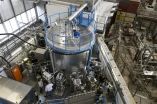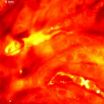'Superglue' for the atmosphere
A research group lead by scientists at the Goethe University Frankfurt discover details on how clouds form
2014-10-09
(Press-News.org) This news release is available in German.
It has been known for several years that sulfuric acid contributes to the formation of tiny aerosol particles, which play an important role in the formation of clouds. The new study by Kürten et al. shows that dimethylamine can tremendously enhance new particle formation. The formation of neutral (i.e. uncharged) nucleating clusters of sulfuric acid and dimethylamine was observed for the first time.
Previously, it was only possible to detect neutral clusters containing up to two sulfuric acid molecules. However, in the present study molecular clusters containing up to 14 sulfuric acid and 16 dimethylamine molecules were detected and their growth by attachment of individual molecules was observed in real-time starting from just one molecule. Moreover, these measurements were made at concentrations of sulfuric acid and dimethylamine corresponding to atmospheric levels (less than 1 molecule of sulfuric acid per 1 x 1013 molecules of air).
The capability of sulfuric acid molecules together with water and ammonia to form clusters and particles has been recognized for several years. However, clusters which form in this manner can vaporize under the conditions which exist in the atmosphere. In contrast, the system of sulfuric acid and dimethylamine forms particles much more efficiently because even the smallest clusters are essentially stable against evaporation. In this respect dimethylamine can act as "superglue" because when interacting with sulfuric acid every collision between a cluster and a sulfuric acid molecule bonds them together irreversibly. Sulphuric acid as well as amines in the present day atmosphere have mainly anthropogenic sources. Sulphuric acid is derived mainly from the oxidation of sulphur dioxide while amines stem, for example, from animal husbandry. The method used to measure the neutral clusters utilizes a combination of a mass spectrometer and a chemical ionization source, which was developed by the University of Frankfurt and the University of Helsinki. The measurements were made by an international collaboration at the CLOUD (Cosmics Leaving OUtdoor Droplets) chamber at CERN (European Organization for Nuclear Research).
The results allow for very detailed insight into a chemical system which could be relevant for atmospheric particle formation. Aerosol particles influence the Earth's climate through cloud formation: Clouds can only form if so-called cloud condensation nuclei (CCN) are present, which act as seeds for condensing water molecules. Globally about half the CCN originate from a secondary process which involves the formation of small clusters and particles in the very first step followed by growth to sizes of at least 50 nanometers. The observed process of particle formation from sulfuric acid and dimethylamine could also be relevant for the formation of CCN. A high concentration of CCN generally leads to the formation of clouds with a high concentration of small droplets; whereas fewer CCN lead to clouds with few large droplets. Earth's radiation budget, climate as well as precipitation patterns can be influenced in this manner. The deployed method will also open a new window for future measurements of particle formation in other chemical systems.
INFORMATION:
[Attachments] See images for this press release:

ELSE PRESS RELEASES FROM THIS DATE:
2014-10-09
New Rochelle, NY, October 9, 2014—Laser Solid Forming (LSF) is an innovative method for direct fabrication of metallic components in additive manufacturing. Renowned researchers Weidong Huang and Lin Xin, from China's Northwestern Polytechnical University, Shaanxi, describe their progress and applications with LSF technology and the excellent mechanical properties of the metallic parts produced in a Review article in 3D Printing and Additive Manufacturing, a peer-reviewed journal from Mary Ann Liebert, Inc., publishers. The article is available free on the 3D Printing ...
2014-10-09
WASHINGTON, Oct. 9, 2014—Some people might consider mucus an icky bodily secretion best left wrapped in a tissue, but to a group of researchers from the University of North Carolina at Chapel Hill, snot is an endlessly fascinating subject. The team has developed a way to use gold nanoparticles and light to measure the stickiness of the slimy substance that lines our airways. The new method could help doctors better monitor and treat lung diseases such as cystic fibrosis and chronic obstructive pulmonary disease.
The research team will present their work at The ...
2014-10-09
Researchers from the National Cancer Institute report that decaffeinated coffee drinking may benefit liver health. Results of the study published in Hepatology, a journal of the American Association for the Study of Liver Diseases, show that higher coffee consumption, regardless of caffeine content, was linked to lower levels of abnormal liver enzymes. This suggests that chemical compounds in coffee other than caffeine may help protect the liver.
Coffee consumption is highly prevalent with more than half of all Americans over 18 drinking on average three cups each day ...
2014-10-09
VIDEO:
The 'heart attack in a dish' experiment reveals that the mitochondria--or cellular powerhouses--of heart muscle cells flicker and oscillate following heart attack and disrupt the heart's entire electrical system...
Click here for more information.
Heart attack survivors often experience dangerous heart rhythm disturbances during treatment designed to restore blood flow to the injured heart muscle, a common and confounding complication of an otherwise lifesaving intervention. ...
2014-10-09
This news release is available in German. The Ebola epidemic in West Africa appears to be spiralling out of control. More than ever, local and global health authorities want to know how the epidemic will develop and, above all, how to prevent it from spreading further. Certain parameters help them to determine this, such as the reproductive number, which is the average number of infections caused by a single infected individual. The incubation and infectious periods are also highly relevant; i.e. the time from infection to the onset of symptoms and the time from onset ...
2014-10-09
Antimicrobial usage in animals in Denmark continued to increase in 2013 – mainly due to an increased use in pigs. However, antimicrobial use in pigs is still 12% lower than in 2009. In general, livestock received very little of the critically important antimicrobials, which are used to treat humans. These findings appear in the annual DANMAP report from Statens Serum Institut and the National Food Institute, Technical University of Denmark. DANMAP is the Danish integrated antimicrobial resistance monitoring and research programme.
In 2013, the total use of antimicrobials ...
2014-10-09
This news release is available in German. Only recently, the UN Climate Summit came together in New York to further address the necessary measures to protect the Earth from a dramatic climate change. It has long been recognised that an increase of the average temperature will cause rising oceans and thus flooded landscapes. Particularly, regions close to the coasts are endangered. While it is well known that climate change has increased average temperatures, it is less clear how temperature variability has altered with climate change.
Postdoctoral fellow George Wang, ...
2014-10-09
The risk of having another stroke is higher if patients, after dilation of their blood vessels in the brain, not only receive clot-inhibiting drugs, but also have small tubes called stents inserted. However, studies have provided no hint of a benefit from stenting, which is also referred to with the abbreviation "PTAS". This is the conclusion reached in the rapid report of the German Institute for Quality and Efficiency in Health Care (IQWiG), as published on 9 October 2014.
Stents are supposed to prevent restenosis
Blood vessels in the brain that are narrowed or blocked ...
2014-10-09
Scientists at the University of Southampton have identified key characteristics that enhance a nanoparticle's ability to penetrate skin, in a milestone study which could have major implications for the delivery of drugs.
Nanoparticles are up to 100,000 times smaller than the thickness of a human hair and drugs delivered using them as a platform, can be more concentrated, targeted and efficient than those delivered through traditional means.
Although previous studies have shown that nanoparticles interact with the skin, conditions in these experiments have not been sufficiently ...
2014-10-09
Conventional estimates for the collapse of the Aegean civilization may be incorrect by up to a century, according to new radiocarbon analyses.
While historical chronologies traditionally place the end of the Greek Bronze Age at around 1025 BCE, this latest research suggests a date 70 to 100 years earlier.
Archaeologists from the University of Birmingham selected 60 samples of animal bones, plant remains and building timbers, excavated at Assiros in northern Greece, to be radiocarbon dated and correlated with 95.4% accuracy using Bayesian statistical methodology at the ...
LAST 30 PRESS RELEASES:
[Press-News.org] 'Superglue' for the atmosphere
A research group lead by scientists at the Goethe University Frankfurt discover details on how clouds form


